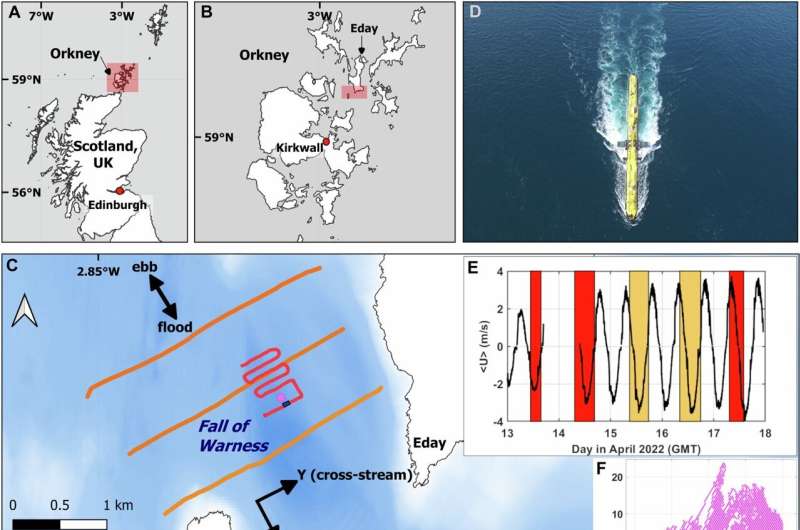
The number of tidal power and other offshore renewable energy installations is set to grow significantly around the UK coastline over the coming decades.
However, launching state-of-the-art devices into often turbulent ocean flows has the potential to pose a range of challenges for the tidal energy industry, including uncertainty around how they may interact with the environment.
To address that, a team of scientists used a combination of aerial drone technology and boat-based surveys to map out the complex tidal flows encountered by the world’s most powerful tidal turbine—Orbital Marine Power’s O2, sited in the heart of the Orkney Islands, Scotland.
Unlike conventional tidal stream turbines, the O2 floats on the sea surface, anchored by mooring lines to the seabed. The platform is over 70 meters long and is connected to the grid at the European Marine Energy Centre (EMEC), with estimates that it could power 2,000 UK homes per year.
The study included highlighting how changing tidal flows, that exceed 8 knots, could impact the device and its performance, but also how the O2’s wake downstream could impact the placing of other turbines as well as marine habitats.
Through this, the scientists provide new insights around the optimal placement of tidal stream turbines, while emphasizing the importance of site-specific assessments at potential turbine sites to help bridge the gap between real-world measurements and computer simulations.
They also hope their approach can be used to address uncertainties surrounding interactions with the natural environment and marine habitats.
A previous study by the lead authors found that a turbine wake generated a predictable foraging hotspot for nearby breeding seabirds. However, if the turbine arrays are too tightly packed it could restrict the movement of some marine fauna.
In addition to seabirds, the authors encountered orcas traveling past the turbine during one of their drone surveys, demonstrating the importance of addressing this.
The study, published in Nature Communications, was conducted by researchers from the Marine Biological Association (MBA), the University of Plymouth, and the University of the Highlands and Islands (UHI) Shetland.
“Conducting oceanographic surveys in one of the world’s most powerful tidal streams, where currents can exceed 8 knots, is both exhilarating and challenging. Yet collecting data in these turbulent environments is crucial for addressing some of the complexities the tidal energy industry faces today. The optimal placement of these turbines in narrow channels fringed by islands is a complex endeavor, but our novel methods provided robust insights into these turbulent flows and wake signatures,” says Dr. Lilian Lieber, senior research fellow.
Tidal power is seen as one of the more reliable sources of clean energy, with the tides—unlike wind and waves—being both regular and predictable.
The turbines, designed to harness tidal power near the sea surface, work much like windmills underwater and convert the kinetic energy of moving water into electricity. But with water being over 800 times denser than air, they generate more energy than wind turbines of the same size.
In future, it is envisaged there could be more installations around the UK, with previous research by those involved in the current study suggesting tidal stream energy could meet up to 11% of the UK’s annual electricity demands.
Shaun Fraser, Senior Scientist and Fisheries Lead from UHI Shetland, added, “This study showcases the benefits of combining scientific expertise and deploying new technologies so that significant progress can be made in understanding dynamic tidal environments. With further development of marine renewable energy infrastructure in the Highlands and Islands region likely in the near future, this work is more relevant than ever to local industries and communities.”
Despite the promise of tidal energy, the sector still faces substantial challenges, including the costs of scaling up the technology, grid connection capacity, and ensuring turbines can continue to function in extremely turbulent currents.
The new study aimed to address some of those challenges by advancing field measurement techniques necessary to inform the long-term reliability and sustainable development of tidal technologies.
“Whether it is floating offshore wind farms in the Celtic Sea or tidal turbines off the coast of Scotland, we are going to see more offshore renewable energy platforms being installed all around the UK coastline over the coming decades. However, the natural conditions in the waters around the UK are incredibly varied and complex, something that it is impossible to fully replicate in controlled laboratory experiments or computer simulations.
“This study demonstrates a cost-effective means of countering that, and if we are to get the greatest benefits from the clean energy revolution, assessments that factor in real-world environmental conditions will be of critical importance,” says Alex Nimmo Smith, professor of marine science and technology.
